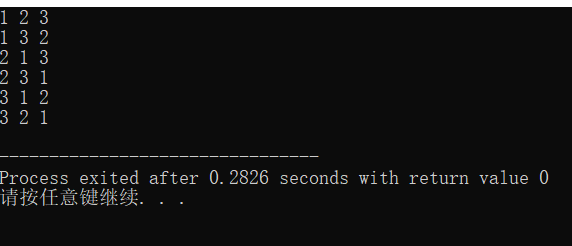c++中的全排列
next_permutation函数
组合数学中经常用到排列,这里介绍一个计算序列全排列的函数:next_permutation(start,end),和prev_permutation(start,end)。这两个函数作用是一样的,区别就在于前者求的是当前排列的下一个排列,后一个求的是当前排列的上一个排列。至于这里的“前一个”和“后一个”,我们可以把它理解为序列的字典序的前后,严格来讲,就是对于当前序列pn,他的下一个序列pn+1满足:不存在另外的序列pm,使pn<pm<pn+1.
对于next_permutation函数,其函数原型为:
#include <algorithm>
bool next_permutation(iterator start,iterator end)
当当前序列不存在下一个排列时,函数返回false,否则返回true
同时,相对应的,上一个排列即为prev_permutation(int *begin, int *end)
看如下代码:
#include <iostream> #include <algorithm> using namespace std; int main() { int num[3]={1,2,3}; do { cout<<num[0]<<" "<<num[1]<<" "<<num[2]<<endl; }while(next_permutation(num,num+3)); return 0; }
运行结果如图:

注意:当我们把while(next_permutation(num,num+3))中的3改为2时,输出就变为了下图所示:

说明此时只针对1,2进行了全排列,有两个,后面的3没有变化,同时改变了数组前两个的值。
由此可以看出,next_permutation(num,num+n)函数是对数组num中的前n个元素进行全排列,同时并改变num数组的值。
另外,需要强调的是,next_permutation()在使用前需要对欲排列数组按升序排序,否则只能找出该序列之后的全排列数。
比如,如果数组num初始化为3,1,2,那么输出就变为了:

维基百科上全排列的实现:
循环法:
#include <iostream> using namespace std; bool arrsame(int* arr, int len, int num) { int i; for (i = 0; i < len; i++) if (arr[i] == num) break; return i != len; } bool next_perm(int* perm, const int k, const int n) { int i = k - 1; do perm[i]++; while (arrsame(perm, i, perm[i]) || (perm[i] >= n && i--)); if (perm[0] >= n) return 0; for (int num = 0, seat = i + 1; seat < k; num++) if (!arrsame(perm, i + 1, num)) perm[seat++] = num; return 1; } int main() { int n, k; cout << "perm(n,k):" << endl; cin >> n >> k; if (n < k || k <= 0) return 0; int* perm = new int[k]; for (int i = 0; i < k; i++) perm[i] = i; do for (int i = 0; i < k; cout << ((++i < k) ? ',' : '\n')) cout << perm[i] + 1; while (next_perm(perm, k, n)); delete[] perm; return 0; }
递归法:
#include <bits/stdc++.h> using namespace std; struct prem { int len; vector<int> used, position; function<void(vector<int>&)> action; prem(int l = 0, function<void(vector<int>&)> a = [](vector<int>& position) {}) : len(l), used(l, -1), position(l), action(a) {} void run(int now = -1) { if (now == len - 1) { action(position); return; } int next = now + 1; for (int i = 0; i < len; i++) { if (used[i] == -1) { used[i] = next; position[next] = i; run(next); used[i] = -1; } } } }; int main() { ios::sync_with_stdio(false), cin.tie(0); int len = 4; prem p(len, [&](vector<int>& p) { for (int i = 0; i < len; i++) { cout << p[i] << " "; } cout << endl; }); p.run(); return 0; }
next_permutation 可以自定义比较函数 例如:POJ 1256
题目中要求的字典序是:A'<'a'<'B'<'b'<...<'Z'<'z',所以在用函数之前必须得按照题目要求的进行排序
#include<iostream> //poj 1256 Anagram #include<string.h> #include<algorithm> using namespace std; int cmp(char a,char b) { if(tolower(a)!=tolower(b))//tolower 是将大写字母转化为小写字母. return tolower(a)<tolower(b); else return a<b; } int main() { char ch[20]; int n; cin>>n; while(n--) { scanf("%s",ch); sort(ch,ch+strlen(ch),cmp); do { printf("%s\n",ch); }while(next_permutation(ch,ch+strlen(ch),cmp)); } return 0; }
.


